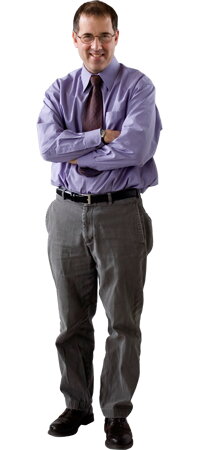
Contact Information
University of Illinois
A506 CLSL, Box 3-6
600 South Mathews Avenue
Urbana, IL 61801
Biography
Professor Andrew A. Gewirth received his A.B. from Princeton University in 1981 and his Ph.D. from Stanford University in 1987. He joined the Illinois faculty in 1988 after postdoctoral work at the University of Texas, Austin. Research in his group focuses on the structure and reactivity of surfaces and interfaces.
Research Interests
inorganic spectroscopy; scanning tunneling microscopy; interfacial electrochemistry; materials properties of surfaces; spectroscopic and probe microscopic characterization of surfaces in varied environments
Research Description
Research in our group focuses on the structure and reactivity of surfaces and interfaces. We utilize local probe microscopies in conjunction with electrochemical, computational, and spectroscopic methods. Electrochemical use of the Atomic Force Microscope (AFM) was developed in our laboratory.
Metal surfaces in electrochemical environments are important in satisfying future energy and remediation needs. One focus of recent activity is the four electron electroreduction of O2 to H2O. Despite intensive effort, little is understood about this reaction, which complicates design of new catalysts. We are using spectroscopic means on well-defined catalyst surfaces along with computational methods to interrogate intermediates and understand the mechanism of this reaction. The insight we obtain from these studies is used to design materials that may exhibit enhanced activity. We emphasize coupling inorganic materials, such as polyoxometalates, with electrochemical activity. These surfaces have potential use in fuel cells and other energy-related applications.
We examine electrode surfaces in order to elucidate properties of the electrochemical double layer and focus on fundamental properties of the electrified solid-liquid interface. For example, we use vibrational spectroscopic means to address, for the first time, the structure of water at this interface and the way in which the water molecules interact with the anions and cations that constitute the double layer. A related effort uses potential dependent "force spectroscopy" with the AFM to examine the composition of electrode materials.
Electrodeposition of Cu is the preferred method today to metallize semiconductors. Small organic and inorganic molecules control the texture of the electrodeposit, and developing an understanding of the way in which these molecules act becomes increasingly important as feature sizes decrease. We use vibrational spectroscopy and probe microscopy to interrogate these molecules and understand the way in which they moderate the electron transfer process occurring during deposition.
A new focus examines the behavior of supported phospholipid bilayers both by themselves and after introduction of relevant materials including polymers and proteins. We examine the interaction of different proteins with each other and with other constituents of the bilayer film as a function of external variables such as temperature, pressure, and applied field. These measurements are providing insight into the behavior of proteins and other constituents in cell membranes.
Awards and Honors
University of Illinois Scholar, 1995
University of Illinois Scholar, 1995
DOE Outstanding Accomplishment in Materials Science, 1993
Fellow, UIUC Center for Advanced Study, 1991
Presidential Young Investigator Award, 1990
Additional Campus Affiliations
Peter C. and Gretchen Miller Markunas Professor, Chemistry
Professor, Chemistry
Professor, Materials Research Lab
External Links
Honors & Awards
University of Illinois Scholar, 1995
University of Illinois Scholar, 1995
DOE Outstanding Accomplishment in Materials Science, 1993
Fellow, UIUC Center for Advanced Study, 1991
Presidential Young Investigator Award, 1990
Recent Publications
Gaddam, R., Wang, Z., Li, Y., Harris, L. C., Pence, M. A., Guerrero, E. R., Kenis, P. J. A., Gewirth, A. A., & Rodríguez-López, J. (2025). Identifying Reactive Trends in Glycerol Electro-Oxidation Using an Automated Screening Approach: 28 Ways to Electrodeposit an Au Electrocatalyst. ACS Catalysis, 15(2), 639-652. https://doi.org/10.1021/acscatal.4c04190
Harris, L. C., Gaines, R. N., Hua, Q., Lindsay, G. S., Griebler, J. J., Kenis, P. J. A., & Gewirth, A. A. (2025). Effect of glycerol concentration on rate and product speciation for Ni and Au-based catalysts. Physical Chemistry Chemical Physics, 27(18), 9855-9863. https://doi.org/10.1039/d4cp04013a
Lindsay, G. S., Rohde, D., Wendeln, C., Vazhenin, G., & Gewirth, A. A. (2025). Using SERS to Evaluate Additive Kinetics During Reverse Pulse Plating of Cu. Journal of the Electrochemical Society, 172(4), Article 042501. https://doi.org/10.1149/1945-7111/adc513
Paliwal, A., Li, B., Long, H., Assaf, L., Haasch, R. T., Gupta, J. K., Reynolds, M. A., Son, Y. J., Zhang, K., Ye, S., Kenis, P. J. A., & Gewirth, A. A. (2025). Inhibition of Nitrogen Poisoning on Pt during Ammonia Oxidation through Early Transition Metal Oxide Supports. ACS Catalysis, 15(12), 10856-10867. https://doi.org/10.1021/acscatal.5c01870
Paliwal, A., Assaf, L., Long, H., Haasch, R. T., Gupta, J. K., Reynolds, M. A., Son, Y. J., Zhang, K., Kenis, P. J. A., & Gewirth, A. A. (2025). Mechanistic Insights into the Enhanced Ammonia Oxidation Activity of PtRh Electrodeposits. ACS Applied Materials and Interfaces, 17(2), 3383-3392. https://doi.org/10.1021/acsami.4c18649